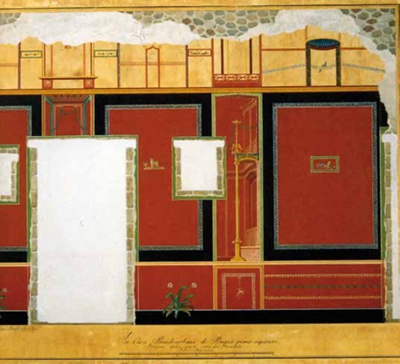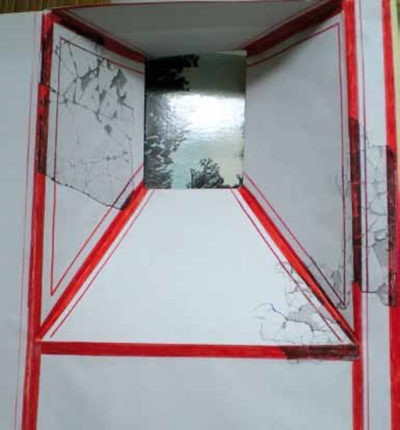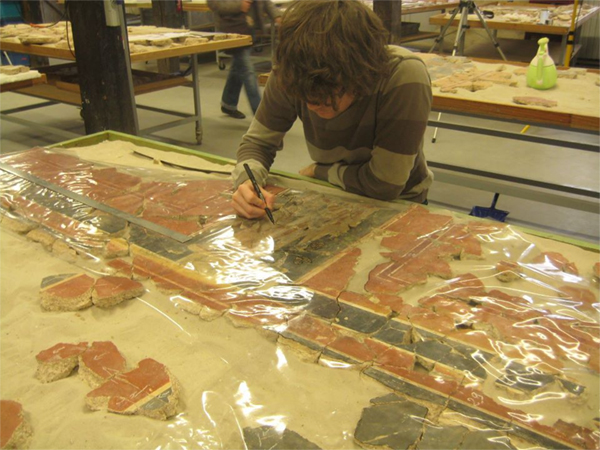To be or not to be a toichographologist?
Nicolas Delferrière
Université Clermont-Auvergne
Toichographology is an archaeological discipline dedicated to the excavation and study of ancient wall paintings and stucco. The name comes from the ancient Greek τοῖχος (toichos or "wall"), γράφειν (graphein or "to write", "to paint", "to draw") and λόγος (logos or "science"). A specialist in this discipline is a toichographologist. The creation of a genuine speciality is illustrated by the fact that the the study of painted plaster and stucco was officially named by the Académie Française in 2012: “toichographologie” (toichographology) (Dardenay and Boislève 2014: 5; Schnitzler 2014: 8; Vannier 2014: 255-256).
Long understood through the prism of art history, the study of Gallo-Roman architectural coatings (painted plaster, stucco, mosaics, paving and veneering) lies at a crossroads of disciplines and methods. Research in this area reaches beyond simple aesthetics and is a recognized specialty in the field of archaeology. Toichographology reveals and gives voice to architecture, which in turn provides substantial archaeological data. Decorations that are not mobile are an integral part of the architecture that they cover and characterize. Decoration and architecture each take on their full meaning only in relation to each other. The title of 17th century French architect André Félibien’s book, published in 1690, is a perfect illustration of this close relationship: Principes de l'architecture, de la sculpture, de la peinture et des autres arts qui en dépendent (lit. The Principles of architecture, sculpture, painting, and the other arts that depend on them).
Toichographology in archaeology
Toichographology enables us to reconstruct lost architecture. It traces walls, revealing their construction materials, heights, doorways and windows, ceilings and vaults, and their various fittings (staircases or niches). All of these are essential elements for understanding and reconstructing spaces that no longer exist (Allag 2011; Eristov 2014). See Figures 2-3.
Meticulous observation enables us to understand the restoration of decor and the architectural reorganization of decorated rooms (Boislève 2016). The aesthetic and technical choices made are illuminated, including the choice of materials such as pigments and mortars. These can help to characterize the different areas of a building (public, private, craft, agricultural or residential), and to establish a hierarchy between them. For example, they help us to sketch out a socio-cultural image of those who commissioned the work and to glimpse the role(s) of the craftsmen involved (Delferrière and Serrano 2018).

Figure 2. Openings in a painted wall. Villa of Diomède, drawing by F. Morelli (Soprintendenza archeologica di Napoli ADS 1129; after Allag 2011: 571, fig. 5).

Figure 3. Reconstruction of an embrasure with fragments of painted plaster discovered in the Place des Épars in Chartres. Photo and reconstruction by Claudine Allag (after Allag 2011: 572, fig. 7).
To preserve renderings and retain as much information as possible (which is essential for reconstruction), the toichographologist works in the field to remove the fragments of wall paintings in accordance with specific protocols. This depends on whether the renderings are still located on a wall, have collapsed in situ or are in a secondary position. For example, plaster preserved in situ on the wall requires very detailed cleaning, a 1:1 scale graphic survey and photographic records, whereas plaster that has collapsed is sampled by square and a dismantling plan is drawn up.
After meticulous cleaning with water (brush for the edges and reverse and sponge for the pictorial surface) in the laboratory, the longest phase of the toichographer's work is the reassembly of fragments, which is akin to a large-scale jigsaw puzzle. This is the actual reconstitution of the decoration so that it can be understood as clearly as possible. Once the pieces have been reassembled, they are photographed and drawn at 1:1 scale. See Figure 4.

Figure 4. Graphic sketch of the painted decoration after it has been assembled. Photo by Olga Romanenko, 2012.
The final phase of the toichographer's work is reconstruction. This involves precise observation of the decoration. It also includes identifying technical aspects that may indicate the presence of any openings. The resulting document incorporates the drawing or photograph of the reassembled plates and consists of rendering the general organization of the decor, showing only the real elements on which a reconstruction is based (Boislève 2014; Barbet 2016; Dardenay et al. 2019).
Toichographology is a true discipline in archaeology, providing a wealth of data that is indispensable for creating a better understanding of the architecture of the buildings discovered, particularly in relation to the organization of interior spaces (doors, windows, staircases; location of furniture). A complete study of decorations provides a close-up view of the tastes and culture of owners and/or patrons. The study of pigments is also a source of information about an owner’s wealth; some pigments are expensive imports. Moreover, the precise study of painted plaster also reveals the work of painters and allows us to identify common workshops. Toichographology is, therefore, an archaeological discipline that allows us to take an interest in socio-cultural issues. We must encourage the development of this discipline, as it is a real help to all archaeologists.
Bibliography
-
Allag, C., 2011. Ouvertures, embrasures. In: C. Balmelle, H. Eristov and F. Monier (éd.), Décor et architecture en Gaule, entre l’Antiquité et le Haut Moyen Âge : mosaïque, peinture, stuc, Actes du colloque international, Université de Toulouse II-Le Mirail, 9-12 octobre 2008 : 567-577. Bordeaux (Supplément Aquitania, 20).
-
Barbet, A., 2016. Recomposition et restitution des peintures murales fragmentaires : méthodologie, principes scientifiques et éthiques. Revue Archéologique 2016-2: 361-382.
-
Boislève, J., 2014. Les peintures romaines. De la fouille à la restitution. In: L’Empire de la couleur. La peinture romaine de Pompéi aux Gaules : 70-75 (Dossiers d’Archéologie 366).
-
Boislève, J., 2016. Fouiller et lire les décors peints pour révéler l’architecture. Méthodologie appliquée à l’archéologie préventive. Archéopages 43: 90-101.
-
Dardenay, A. and Boislève, J., 2014. Avant-propos. In: J. Boislève, A. Dardenay and F. Monier (éd.), Peintures et stucs d’époque romaine. Révéler l’architecture par l’étude du décor, Actes du 26e colloque de l’AFPMA, Strasbourg, 16-17 novembre 2012: 5-6. Bordeaux : Ausonius (Pictor 3).
-
Dardenay, A., Mulliez, M. and Mora, P., 2019. Reconstruction of ancient wall paintings: digital painting and three-dimensional restoration of the House of Neptune and Amphitrite in Herculaneum. In : M. Mulliez (éd.), Restituer les couleurs/Reconstruction of Polychromy. Virtual Retrospect, Actes du colloque de novembre-décembre 2017: 67-77. Bordeaux : Ausonius (Archaeovision 8).
-
Delferrière, N. and Serrano, C., 2018. L’intérêt de la toichographologie (étude des enduits peints), quelques exemples lingons. In: C. Serrano (dir.), Sciences d’aujourd’hui pour comprendre hier : les techniques de l’archéologie appliquées à la Haute-Marne. Catalogue d’exposition, Archives départementales de la Haute-Marne, Chamarandes-Choignes, 15 juin-21 décembre 2018: 105-116.
-
Eristov, H., 2014. L’architecture révélée par sa peau : l’apport des enduits muraux. In: P. Capus and A. Dardenay (éd.), L’Empire de la Couleur, de Pompéi au sud des Gaules. Catalogue d’exposition présentée au Musée des Antiques, Saint-Raymond de Toulouse, du 15 novembre 2014 au 22 mars 2015: 104-113.
-
Schnitzler, B., 2014. Introduction. In: J. Boislève, A. Dardenay and F. Monier (éd.), Peintures et stucs d’époque romaine. Révéler l’architecture par l’étude du décor, Actes du 26e colloque de l’AFPMA, Strasbourg, 16-17 novembre 2012: 7-8. Bordeaux : Ausonius (Pictor 3).
-
Vannier, P., 2014. Un nom pour une discipline : l’étude des peintures murales antiques. In: J. Boislève, A. Dardenay and F. Monier (éd.), Peintures et stucs d’époque romaine. Révéler l’architecture par l’étude du décor, Actes du 26e colloque de l’AFPMA, Strasbourg, 16-17 novembre 2012: 255-257. Bordeaux : Ausonius (Pictor 3).
Go back to top